Located at 16°31’30” N latitude and 111°46’05” E longitude, the “Eye of the South China Sea” captivates observers when viewed from high altitudes. The periphery of this mysterious cavity exhibits a profound blue color, deepening to an almost black shade at its center, resembling a gateway to an unknown world. In 2016, this remarkable site was officially named the Sansha Yongle Blue Hole.
For centuries, the mystery surrounding the Yongle Blue Hole has given rise to various legends. Some claim that the legendary Ding Hai Shen Zhen (the numinous needle that stabilizes the sea), is hidden within the depths. According to folklore, Sun Wukong, the Monkey King, transformed the needle into his famous gold-banded staff, leaving behind this unfathomable blue hole.

In fact, such marine blue holes exist worldwide, including the Great Blue Hole in Belize, the Blue Hole in the Red Sea, and Dean’s Blue Hole in the Bahamas. However, the Yongle Blue Hole, situated in the Xisha Islands, has been explored to a record depth of 300.89 meters, making it the deepest known blue hole on Earth.
Chinese researchers have discovered that the water within the Yongle Blue Hole lacks noticeable flow and is not connected to the outside sea. The upper part of the hole is a vertical cave with a diameter of over 130 meters, narrowing down to just 36 meters at the bottom. The upper layers of the water in the hole host more than 20 marine species, including giant clams and parrotfish, similar to the surrounding sea. However, below 80 meters, the oxygen levels drop rapidly, and by 100 meters, the blue hole becomes an anoxic environment.

How did this blue hole form? When did it form? Could there be mysterious creatures unseen by human eyes in the depths of this blue hole? Despite advancements in science, the phenomenon of blue holes remains shrouded in mystery, rightfully holding the title of the “last legacy on Earth preserving the secrets of the universe.” Perhaps one day, the Yongle Blue Hole will unveil answers to the enigmas of climate, ecology, and geomorphological changes in the South China Sea over millennia.

